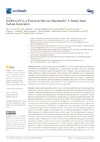Identificador persistente para citar o vincular este elemento:
https://accedacris.ulpgc.es/jspui/handle/10553/107555
| Campo DC | Valor | idioma |
|---|---|---|
| dc.contributor.author | Audino, Tania | en_US |
| dc.contributor.author | Grattarola, Carla | en_US |
| dc.contributor.author | Centelleghe, Cinzia | en_US |
| dc.contributor.author | Peletto, Simone | en_US |
| dc.contributor.author | Giorda, Federica | en_US |
| dc.contributor.author | Florio, Caterina Lucia | en_US |
| dc.contributor.author | Caramelli, Maria | en_US |
| dc.contributor.author | Bozzetta, Elena | en_US |
| dc.contributor.author | Mazzariol, Sandro | en_US |
| dc.contributor.author | Di Guardo, Giovanni | en_US |
| dc.contributor.author | Lauriano, Giancarlo | en_US |
| dc.contributor.author | Casalone, Cristina | en_US |
| dc.date.accessioned | 2021-06-18T07:03:19Z | - |
| dc.date.available | 2021-06-18T07:03:19Z | - |
| dc.date.issued | 2021 | en_US |
| dc.identifier.issn | 2076-2615 | en_US |
| dc.identifier.other | Scopus | - |
| dc.identifier.uri | https://accedacris.ulpgc.es/handle/10553/107555 | - |
| dc.description.abstract | Zoonotically transmitted coronaviruses were responsible for Severe Acute Respiratory Syndrome Coronavirus-2 (SARS-CoV-2), causing the dramatic Coronavirus Disease-2019 (CoViD-19) pandemic, which affected public health, the economy, and society on a global scale. The impact of the SARS-CoV-2 pandemic permeated into our environment and wildlife as well; in particular, concern has been raised about the viral occurrence and persistence in aquatic and marine ecosystems. The discharge of untreated wastewaters carrying infectious SARS-CoV-2 into natural water systems that are home to sea mammals may have dramatic consequences on vulnerable species. The efficient transmission of coronaviruses raises questions regarding the contributions of virus-receptor interactions. The main receptor of SARS-CoV-2 is Angiotensin Converting Enzyme-2 (ACE-2), serving as a functional receptor for the viral spike (S) protein. This study aimed, through the comparative analysis of the ACE-2 receptor with the human one, at assessing susceptibility to SARS-CoV-2 for different species of marine mammals living in Italian waters. We also determined, by means of immunohistochemistry, ACE-2 receptor localization in the lung tissue from different cetacean species, in order to provide a preliminary characterization of ACE-2 expression in the marine mammal respiratory tracts. Furthermore, to evaluate if and how Italian wastewater management and coastal exposition to extreme weather events may led to susceptible marine mammal populations being exposed to SARS-CoV-2, geomapping data were carried out and overlapped. The results showed the potential SARS-CoV-2 exposure for marine mammals inhabiting Italian coastal waters, putting them at risk when swimming and feeding in specific risk areas. Thus, we highlighted the potential hazard of the reverse zoonotic transmission of SARS-CoV-2 infection, along with its impact on marine mammals regularly inhabiting the Mediterranean Sea, while also stressing the need for appropriate action in order to prevent further damage to specific vulnerable populations. | en_US |
| dc.language | eng | en_US |
| dc.relation.ispartof | Animals | en_US |
| dc.source | Animals [EISSN 2076-2615], v. 11 (6), 1663, (Junio 2021) | en_US |
| dc.subject | 240119 Zoología marina | en_US |
| dc.subject | 310907 Patología | en_US |
| dc.subject.other | ACE-2 | en_US |
| dc.subject.other | Italian Wastewater Management Species | en_US |
| dc.subject.other | Marine Mammals | en_US |
| dc.subject.other | SARS-CoV-2 | en_US |
| dc.title | SARS-CoV-2, a threat to marine mammals? A study from Italian seawaters | en_US |
| dc.type | info:eu-repo/semantics/Article | en_US |
| dc.type | Article | en_US |
| dc.identifier.doi | 10.3390/ani11061663 | en_US |
| dc.identifier.scopus | 85107177403 | - |
| dc.contributor.orcid | NO DATA | - |
| dc.contributor.orcid | NO DATA | - |
| dc.contributor.orcid | NO DATA | - |
| dc.contributor.orcid | NO DATA | - |
| dc.contributor.orcid | NO DATA | - |
| dc.contributor.orcid | NO DATA | - |
| dc.contributor.orcid | NO DATA | - |
| dc.contributor.orcid | NO DATA | - |
| dc.contributor.orcid | NO DATA | - |
| dc.contributor.orcid | NO DATA | - |
| dc.contributor.orcid | NO DATA | - |
| dc.contributor.orcid | NO DATA | - |
| dc.contributor.authorscopusid | 57222292745 | - |
| dc.contributor.authorscopusid | 6506971779 | - |
| dc.contributor.authorscopusid | 55573906900 | - |
| dc.contributor.authorscopusid | 22986339200 | - |
| dc.contributor.authorscopusid | 55972238400 | - |
| dc.contributor.authorscopusid | 9235081500 | - |
| dc.contributor.authorscopusid | 55890943700 | - |
| dc.contributor.authorscopusid | 55932050600 | - |
| dc.contributor.authorscopusid | 24173815500 | - |
| dc.contributor.authorscopusid | 36860870100 | - |
| dc.contributor.authorscopusid | 6504406802 | - |
| dc.contributor.authorscopusid | 16177404700 | - |
| dc.identifier.eissn | 2076-2615 | - |
| dc.identifier.issue | 6 | - |
| dc.relation.volume | 11 | en_US |
| dc.investigacion | Ciencias de la Salud | en_US |
| dc.type2 | Artículo | en_US |
| dc.description.notas | This article belongs to the Special Issue Recent advances in Marine Mammal Research | en_US |
| dc.utils.revision | Sí | en_US |
| dc.date.coverdate | Junio 2021 | en_US |
| dc.identifier.ulpgc | Sí | en_US |
| dc.contributor.buulpgc | BU-VET | en_US |
| dc.description.sjr | 0,61 | |
| dc.description.jcr | 3,231 | |
| dc.description.sjrq | Q1 | |
| dc.description.jcrq | Q1 | |
| dc.description.scie | SCIE | |
| dc.description.miaricds | 10,5 | |
| item.grantfulltext | open | - |
| item.fulltext | Con texto completo | - |
| crisitem.author.fullName | Giorda, Federica | - |
| Colección: | Artículos | |
Citas SCOPUSTM
30
actualizado el 08-jun-2025
Citas de WEB OF SCIENCETM
Citations
25
actualizado el 08-jun-2025
Visitas
147
actualizado el 16-nov-2024
Descargas
149
actualizado el 16-nov-2024
Google ScholarTM
Verifica
Altmetric
Comparte
Exporta metadatos
Los elementos en ULPGC accedaCRIS están protegidos por derechos de autor con todos los derechos reservados, a menos que se indique lo contrario.
